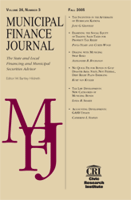The Amazon Effect on Public Finance: What Is the Optimal Tax Structure in the Internet Age?
Author: Tim Russell.; Philip Fischer.; Max Behlke.; Kathleen Quinn McDermott Will & Emery.
Source: Volume 39, Number 01, Spring 2018 , pp.39-63(25)

< previous article |next article > |return to table of contents
Abstract:
State and local government tax systems have not kept pace with the rapid advancements in technology and changing landscape of commerce in the world. Online sales, collaborative consumption, digital goods, and wealth concentration present challenges to current tax systems and have made once reliable revenue streams less predictable. This panel explores the risks to state and local governments, relevant court cases, and options that may be available to policymakers. Tim Russell is principal credit analyst at U.S. Bancorp Asset Management, Inc. Philip Fischer is managing director and head of Fixed Income & Municipal Bond Strategy at Bank of America Merrill Lynch Global Research. Max Behlke, is director of Budget and Tax in the National Conference of State Legislators as well as director of the NCSL Executive Committee Task Force on State and Local Taxation. Kathleen Quinn is an associate at McDermott Will & Emery. This article is based on the authors’ discussions during the panel on “The Amazon Effect on Public Finance: What Is the Optimal Tax Structure in the Internet Age?” at the 35th Annual Conference of the National Federation of Municipal Analysts held in Coronado, California, May 29–June 1, 2018.Keywords: State and local taxation, digital economy, online sales, use tax, wealth concentration, tax revenue streams
Affiliations:
1: U.S. Bancorp Asset Management, Inc.; 2: Bank of America Merrill Lynch Global Research; 3: National Conference of State Legislators.